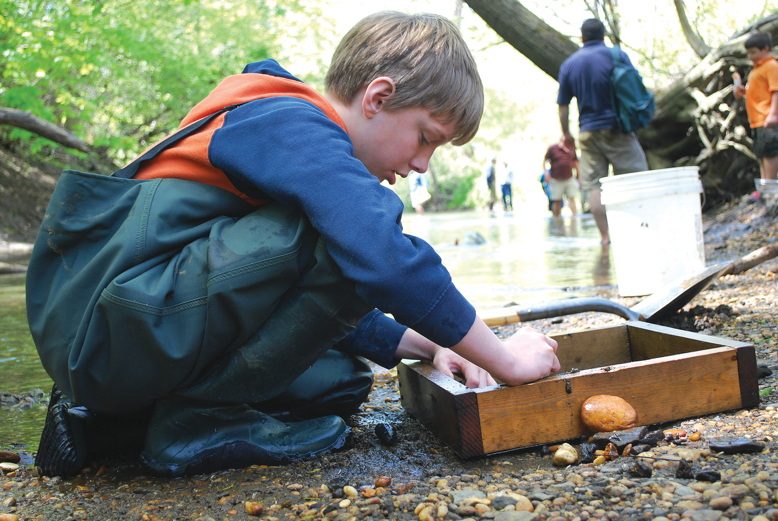
Rust-tinted sand and gravel underlie Big Brook as it flows through Colts Neck. It is a stream like no other in the state. Sifting through its streambed, even an amateur fossil hunter can find links to New Jersey’s prehistoric past in unparalleled abundance.
Each spring, increased water flow from melting snow cuts new veins through the bottom of the stream, revealing a fresh harvest of fossils, from sharks’ teeth to the occasional dinosaur-bone fragment. It was here that dentist and forensics specialist Dr. Paul Kovalski, a well-known Monmouth County fossil collector, discovered a hadrosaur bone in December 2008.
Despite its name, Big Brook has a modest flow, never wider than 25 feet, never deeper than 5 feet. It runs for about 15 miles from the springs and wetlands of northern Marlboro Township into Swimming River Reservoir. In Colts Neck, it flows through Big Brook Preserve, a 143-acre recreational area with hiking trails and easy access to the best sites for fossil hunting.
Some 65 million to 75 million years ago, during what geologists call the Cretaceous period, much of southeastern New Jersey—including modern-day Monmouth and Ocean counties—was underwater and home to a variety of marine species, from sharks and snails to brachiopods, a group of once-abundant shellfish that today are largely extinct.
Big Brook is not the only Monmouth County waterway rife with fossils. Other opportunities to find them exist at Poricy Brook, Ramanessian Brook, Shark River, Willow Brook, Hops Brook and Paul Kovalski Tributary (named for the Monmouth collector). Yet nowhere is the concentration of fossils as impressive as Big Brook. Kovalski describes it as “magical.”
It doesn’t take a big find to experience the magic. A homemade sifter made with pine 2-by-4s and a square of wire mesh is the basic tool. Fossil hunting also requires a pail and shovel with up to a 6-inch blade, as limited by local regulations. (Township rules are posted at the entrance parking lot at 88 Hillsdale Road; permits are required for groups of 15 or more.) Most fossil hunters wear waders or knee-high boots. If the water is warm enough, old sneakers will do.
Big Brook Preserve’s hiking trails wind along the water for nearly half a mile. Get in the water and start hunting. The easiest finds are dramatic-looking exogyra, ancient oysters you don’t need a sifter to spot. Their curvaceous shells—as large as a child’s fist—have a wild, unruly look, as if sculpted out of unglazed clay. Other finds have an air of perfection, including glossy sharks’ teeth and tiny brachiopods.
My son Matt, seven the first time he went fossil hunting here, needed only a few pointers to get started. He focused especially on belemnites, glassy fossils of a creature related to squid that can be spotted underwater, sticking out of the gray clay. Their distinctive, pointed tips make them easy to recognize. Matt was also on the lookout for a rare tooth from a plesiosaur or mosasaur—aquatic animals that prowled the waters here.
Persistence pays. After 10 minutes, Matt made his first find: a perfect reddish belemnite. He proudly thrust his hand toward me, displaying the narrow, projectile-like fossil. “It looks like a bullet,” he declared.
Matt made at least two dozen more finds that day, but left most behind. (Colts Neck township regulations limit the take to five fossils per person per day.) Today the ones he kept are displayed in our living room, perfectly preserved reminders of Jersey’s prehistoric past.
Bruce Edward Litton is a freelance writer and a columnist for Recorder Community Newspapers. He lives in Bedminster.



